Analysis of Management Accounting Techniques for AIRDRI Ltd (UK)
VerifiedAdded on 2021/01/02
|17
|5085
|376
Report
AI Summary
This report delves into management accounting, focusing on costing techniques and budgetary control. It examines marginal and absorption costing methods through the analysis of financial data from AIRDRI Ltd. (U.K), an air dryer manufacturing company. The report provides detailed income statements using both costing methods and interprets the financial data to illustrate their application. Furthermore, the report explores the advantages and disadvantages of various planning tools used for budgetary control, including fixed and flexible budgets. The application of management accounting techniques to solve financial problems is also discussed, providing a comprehensive overview of the subject. The report concludes with a summary of the findings and references used.
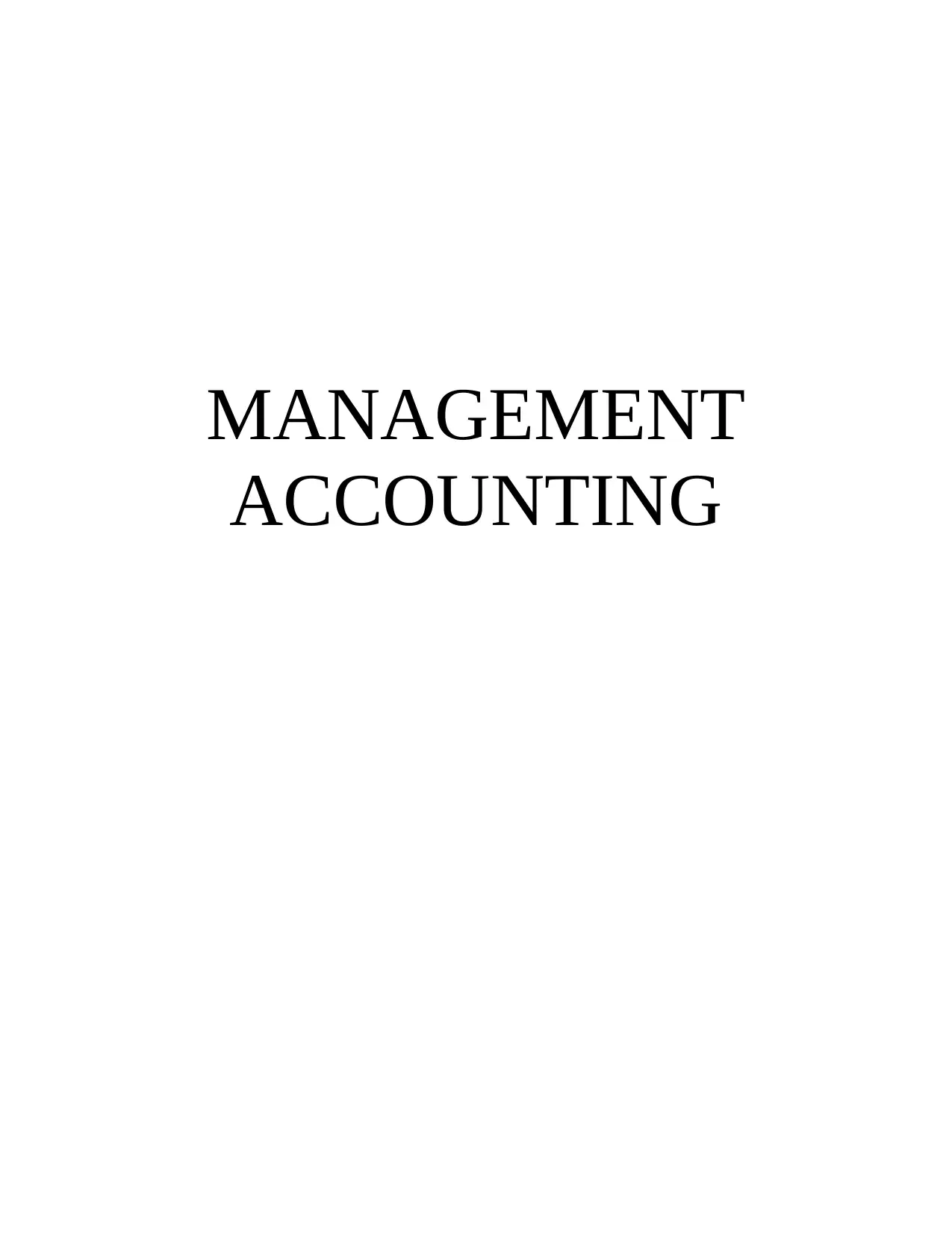
MANAGEMENT
ACCOUNTING
ACCOUNTING
Paraphrase This Document
Need a fresh take? Get an instant paraphrase of this document with our AI Paraphraser
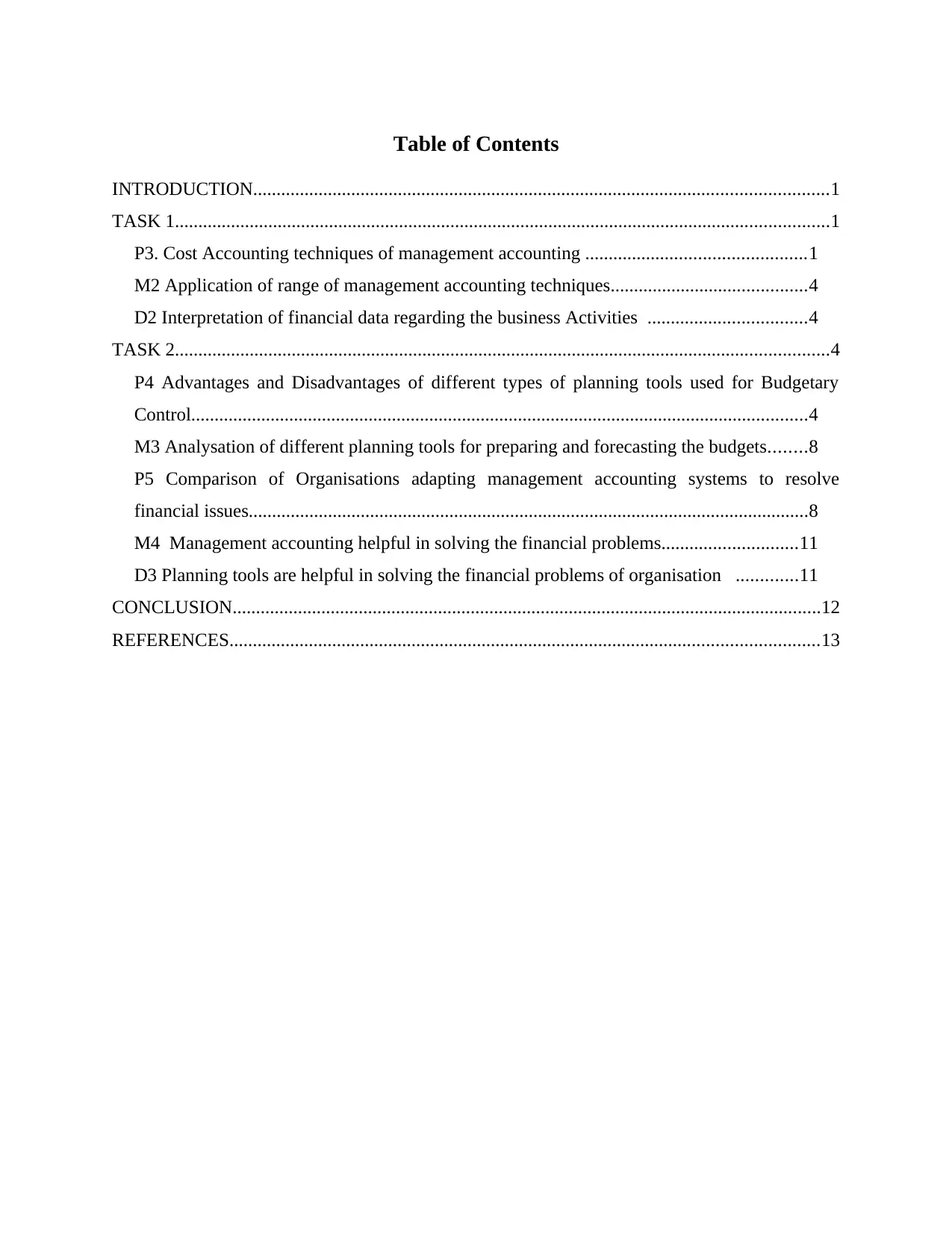
Table of Contents
INTRODUCTION...........................................................................................................................1
TASK 1............................................................................................................................................1
P3. Cost Accounting techniques of management accounting ...............................................1
M2 Application of range of management accounting techniques..........................................4
D2 Interpretation of financial data regarding the business Activities ..................................4
TASK 2............................................................................................................................................4
P4 Advantages and Disadvantages of different types of planning tools used for Budgetary
Control....................................................................................................................................4
M3 Analysation of different planning tools for preparing and forecasting the budgets........8
P5 Comparison of Organisations adapting management accounting systems to resolve
financial issues........................................................................................................................8
M4 Management accounting helpful in solving the financial problems.............................11
D3 Planning tools are helpful in solving the financial problems of organisation .............11
CONCLUSION..............................................................................................................................12
REFERENCES..............................................................................................................................13
INTRODUCTION...........................................................................................................................1
TASK 1............................................................................................................................................1
P3. Cost Accounting techniques of management accounting ...............................................1
M2 Application of range of management accounting techniques..........................................4
D2 Interpretation of financial data regarding the business Activities ..................................4
TASK 2............................................................................................................................................4
P4 Advantages and Disadvantages of different types of planning tools used for Budgetary
Control....................................................................................................................................4
M3 Analysation of different planning tools for preparing and forecasting the budgets........8
P5 Comparison of Organisations adapting management accounting systems to resolve
financial issues........................................................................................................................8
M4 Management accounting helpful in solving the financial problems.............................11
D3 Planning tools are helpful in solving the financial problems of organisation .............11
CONCLUSION..............................................................................................................................12
REFERENCES..............................................................................................................................13

⊘ This is a preview!⊘
Do you want full access?
Subscribe today to unlock all pages.

Trusted by 1+ million students worldwide
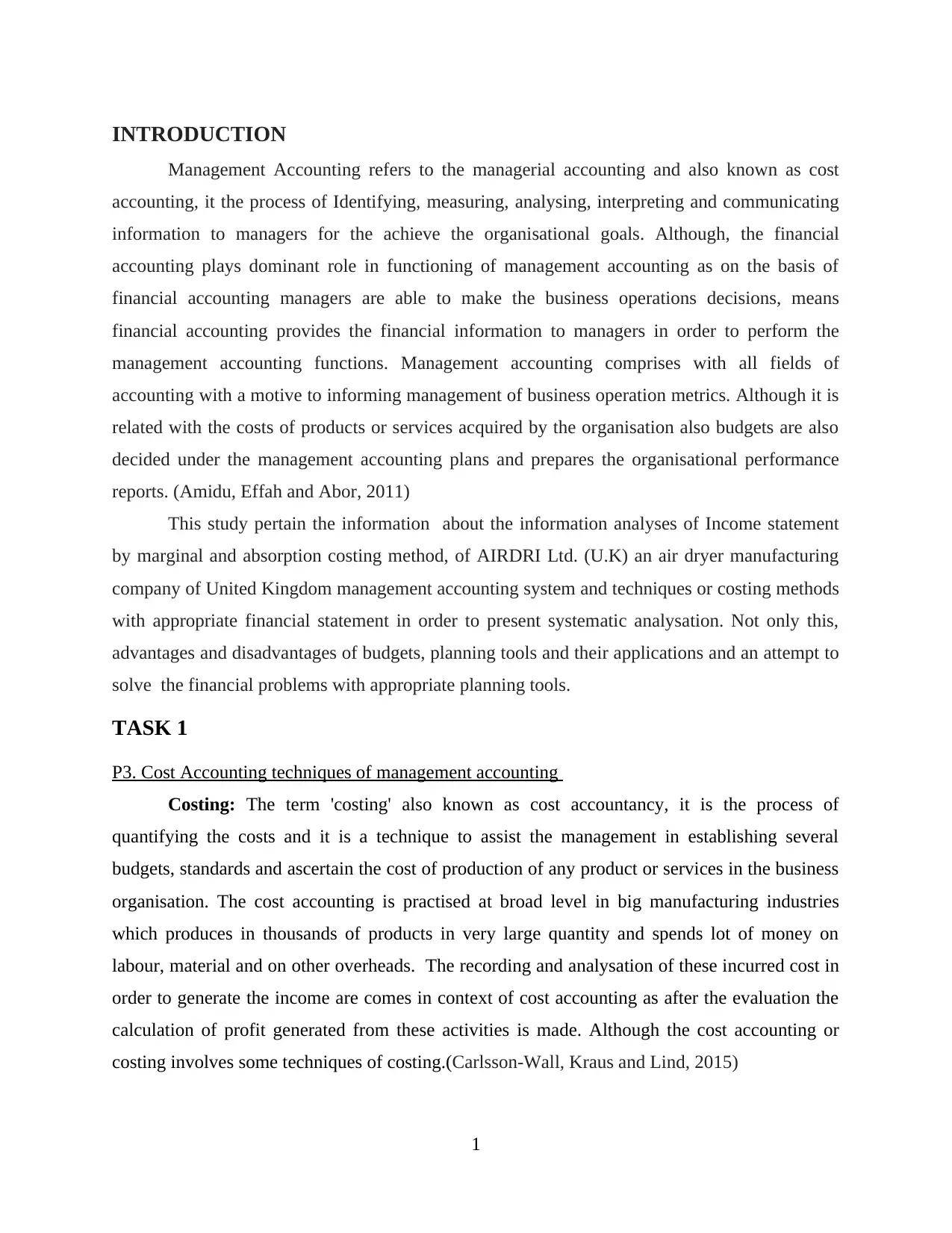
INTRODUCTION
Management Accounting refers to the managerial accounting and also known as cost
accounting, it the process of Identifying, measuring, analysing, interpreting and communicating
information to managers for the achieve the organisational goals. Although, the financial
accounting plays dominant role in functioning of management accounting as on the basis of
financial accounting managers are able to make the business operations decisions, means
financial accounting provides the financial information to managers in order to perform the
management accounting functions. Management accounting comprises with all fields of
accounting with a motive to informing management of business operation metrics. Although it is
related with the costs of products or services acquired by the organisation also budgets are also
decided under the management accounting plans and prepares the organisational performance
reports. (Amidu, Effah and Abor, 2011)
This study pertain the information about the information analyses of Income statement
by marginal and absorption costing method, of AIRDRI Ltd. (U.K) an air dryer manufacturing
company of United Kingdom management accounting system and techniques or costing methods
with appropriate financial statement in order to present systematic analysation. Not only this,
advantages and disadvantages of budgets, planning tools and their applications and an attempt to
solve the financial problems with appropriate planning tools.
TASK 1
P3. Cost Accounting techniques of management accounting
Costing: The term 'costing' also known as cost accountancy, it is the process of
quantifying the costs and it is a technique to assist the management in establishing several
budgets, standards and ascertain the cost of production of any product or services in the business
organisation. The cost accounting is practised at broad level in big manufacturing industries
which produces in thousands of products in very large quantity and spends lot of money on
labour, material and on other overheads. The recording and analysation of these incurred cost in
order to generate the income are comes in context of cost accounting as after the evaluation the
calculation of profit generated from these activities is made. Although the cost accounting or
costing involves some techniques of costing.(Carlsson-Wall, Kraus and Lind, 2015)
1
Management Accounting refers to the managerial accounting and also known as cost
accounting, it the process of Identifying, measuring, analysing, interpreting and communicating
information to managers for the achieve the organisational goals. Although, the financial
accounting plays dominant role in functioning of management accounting as on the basis of
financial accounting managers are able to make the business operations decisions, means
financial accounting provides the financial information to managers in order to perform the
management accounting functions. Management accounting comprises with all fields of
accounting with a motive to informing management of business operation metrics. Although it is
related with the costs of products or services acquired by the organisation also budgets are also
decided under the management accounting plans and prepares the organisational performance
reports. (Amidu, Effah and Abor, 2011)
This study pertain the information about the information analyses of Income statement
by marginal and absorption costing method, of AIRDRI Ltd. (U.K) an air dryer manufacturing
company of United Kingdom management accounting system and techniques or costing methods
with appropriate financial statement in order to present systematic analysation. Not only this,
advantages and disadvantages of budgets, planning tools and their applications and an attempt to
solve the financial problems with appropriate planning tools.
TASK 1
P3. Cost Accounting techniques of management accounting
Costing: The term 'costing' also known as cost accountancy, it is the process of
quantifying the costs and it is a technique to assist the management in establishing several
budgets, standards and ascertain the cost of production of any product or services in the business
organisation. The cost accounting is practised at broad level in big manufacturing industries
which produces in thousands of products in very large quantity and spends lot of money on
labour, material and on other overheads. The recording and analysation of these incurred cost in
order to generate the income are comes in context of cost accounting as after the evaluation the
calculation of profit generated from these activities is made. Although the cost accounting or
costing involves some techniques of costing.(Carlsson-Wall, Kraus and Lind, 2015)
1
Paraphrase This Document
Need a fresh take? Get an instant paraphrase of this document with our AI Paraphraser
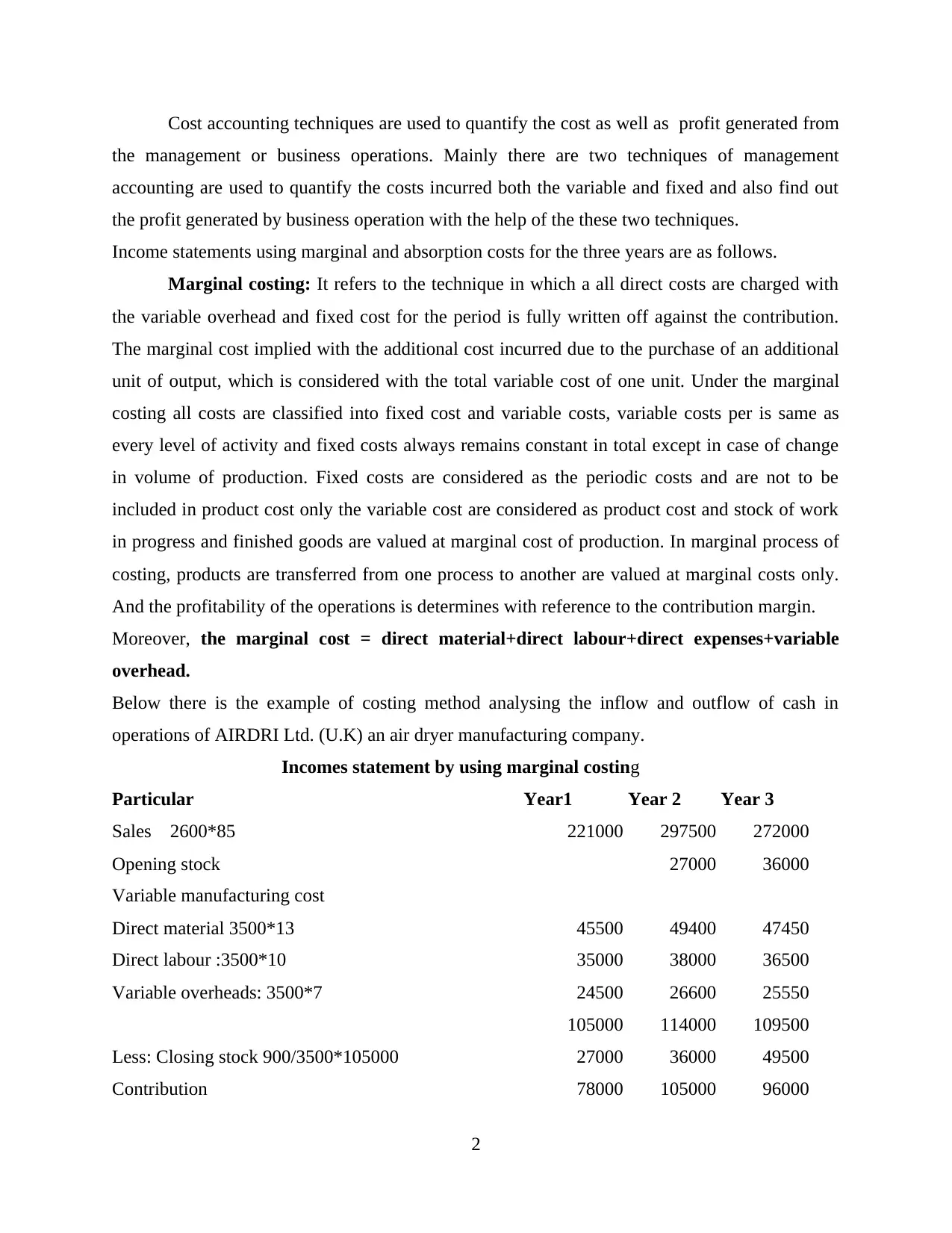
Cost accounting techniques are used to quantify the cost as well as profit generated from
the management or business operations. Mainly there are two techniques of management
accounting are used to quantify the costs incurred both the variable and fixed and also find out
the profit generated by business operation with the help of the these two techniques.
Income statements using marginal and absorption costs for the three years are as follows.
Marginal costing: It refers to the technique in which a all direct costs are charged with
the variable overhead and fixed cost for the period is fully written off against the contribution.
The marginal cost implied with the additional cost incurred due to the purchase of an additional
unit of output, which is considered with the total variable cost of one unit. Under the marginal
costing all costs are classified into fixed cost and variable costs, variable costs per is same as
every level of activity and fixed costs always remains constant in total except in case of change
in volume of production. Fixed costs are considered as the periodic costs and are not to be
included in product cost only the variable cost are considered as product cost and stock of work
in progress and finished goods are valued at marginal cost of production. In marginal process of
costing, products are transferred from one process to another are valued at marginal costs only.
And the profitability of the operations is determines with reference to the contribution margin.
Moreover, the marginal cost = direct material+direct labour+direct expenses+variable
overhead.
Below there is the example of costing method analysing the inflow and outflow of cash in
operations of AIRDRI Ltd. (U.K) an air dryer manufacturing company.
Incomes statement by using marginal costing
Particular Year1 Year 2 Year 3
Sales 2600*85 221000 297500 272000
Opening stock 27000 36000
Variable manufacturing cost
Direct material 3500*13 45500 49400 47450
Direct labour :3500*10 35000 38000 36500
Variable overheads: 3500*7 24500 26600 25550
105000 114000 109500
Less: Closing stock 900/3500*105000 27000 36000 49500
Contribution 78000 105000 96000
2
the management or business operations. Mainly there are two techniques of management
accounting are used to quantify the costs incurred both the variable and fixed and also find out
the profit generated by business operation with the help of the these two techniques.
Income statements using marginal and absorption costs for the three years are as follows.
Marginal costing: It refers to the technique in which a all direct costs are charged with
the variable overhead and fixed cost for the period is fully written off against the contribution.
The marginal cost implied with the additional cost incurred due to the purchase of an additional
unit of output, which is considered with the total variable cost of one unit. Under the marginal
costing all costs are classified into fixed cost and variable costs, variable costs per is same as
every level of activity and fixed costs always remains constant in total except in case of change
in volume of production. Fixed costs are considered as the periodic costs and are not to be
included in product cost only the variable cost are considered as product cost and stock of work
in progress and finished goods are valued at marginal cost of production. In marginal process of
costing, products are transferred from one process to another are valued at marginal costs only.
And the profitability of the operations is determines with reference to the contribution margin.
Moreover, the marginal cost = direct material+direct labour+direct expenses+variable
overhead.
Below there is the example of costing method analysing the inflow and outflow of cash in
operations of AIRDRI Ltd. (U.K) an air dryer manufacturing company.
Incomes statement by using marginal costing
Particular Year1 Year 2 Year 3
Sales 2600*85 221000 297500 272000
Opening stock 27000 36000
Variable manufacturing cost
Direct material 3500*13 45500 49400 47450
Direct labour :3500*10 35000 38000 36500
Variable overheads: 3500*7 24500 26600 25550
105000 114000 109500
Less: Closing stock 900/3500*105000 27000 36000 49500
Contribution 78000 105000 96000
2
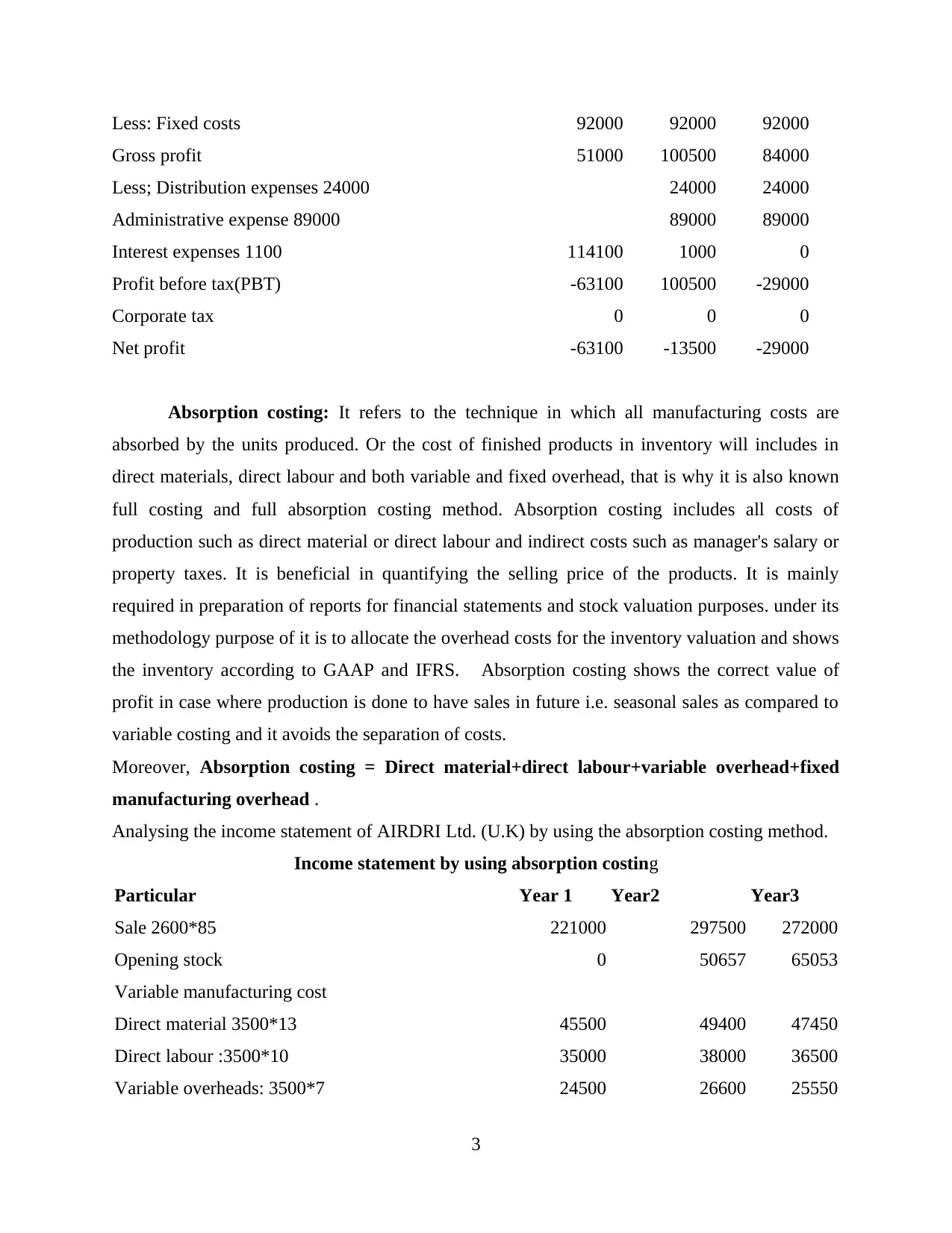
Less: Fixed costs 92000 92000 92000
Gross profit 51000 100500 84000
Less; Distribution expenses 24000 24000 24000
Administrative expense 89000 89000 89000
Interest expenses 1100 114100 1000 0
Profit before tax(PBT) -63100 100500 -29000
Corporate tax 0 0 0
Net profit -63100 -13500 -29000
Absorption costing: It refers to the technique in which all manufacturing costs are
absorbed by the units produced. Or the cost of finished products in inventory will includes in
direct materials, direct labour and both variable and fixed overhead, that is why it is also known
full costing and full absorption costing method. Absorption costing includes all costs of
production such as direct material or direct labour and indirect costs such as manager's salary or
property taxes. It is beneficial in quantifying the selling price of the products. It is mainly
required in preparation of reports for financial statements and stock valuation purposes. under its
methodology purpose of it is to allocate the overhead costs for the inventory valuation and shows
the inventory according to GAAP and IFRS. Absorption costing shows the correct value of
profit in case where production is done to have sales in future i.e. seasonal sales as compared to
variable costing and it avoids the separation of costs.
Moreover, Absorption costing = Direct material+direct labour+variable overhead+fixed
manufacturing overhead .
Analysing the income statement of AIRDRI Ltd. (U.K) by using the absorption costing method.
Income statement by using absorption costing
Particular Year 1 Year2 Year3
Sale 2600*85 221000 297500 272000
Opening stock 0 50657 65053
Variable manufacturing cost
Direct material 3500*13 45500 49400 47450
Direct labour :3500*10 35000 38000 36500
Variable overheads: 3500*7 24500 26600 25550
3
Gross profit 51000 100500 84000
Less; Distribution expenses 24000 24000 24000
Administrative expense 89000 89000 89000
Interest expenses 1100 114100 1000 0
Profit before tax(PBT) -63100 100500 -29000
Corporate tax 0 0 0
Net profit -63100 -13500 -29000
Absorption costing: It refers to the technique in which all manufacturing costs are
absorbed by the units produced. Or the cost of finished products in inventory will includes in
direct materials, direct labour and both variable and fixed overhead, that is why it is also known
full costing and full absorption costing method. Absorption costing includes all costs of
production such as direct material or direct labour and indirect costs such as manager's salary or
property taxes. It is beneficial in quantifying the selling price of the products. It is mainly
required in preparation of reports for financial statements and stock valuation purposes. under its
methodology purpose of it is to allocate the overhead costs for the inventory valuation and shows
the inventory according to GAAP and IFRS. Absorption costing shows the correct value of
profit in case where production is done to have sales in future i.e. seasonal sales as compared to
variable costing and it avoids the separation of costs.
Moreover, Absorption costing = Direct material+direct labour+variable overhead+fixed
manufacturing overhead .
Analysing the income statement of AIRDRI Ltd. (U.K) by using the absorption costing method.
Income statement by using absorption costing
Particular Year 1 Year2 Year3
Sale 2600*85 221000 297500 272000
Opening stock 0 50657 65053
Variable manufacturing cost
Direct material 3500*13 45500 49400 47450
Direct labour :3500*10 35000 38000 36500
Variable overheads: 3500*7 24500 26600 25550
3
⊘ This is a preview!⊘
Do you want full access?
Subscribe today to unlock all pages.

Trusted by 1+ million students worldwide
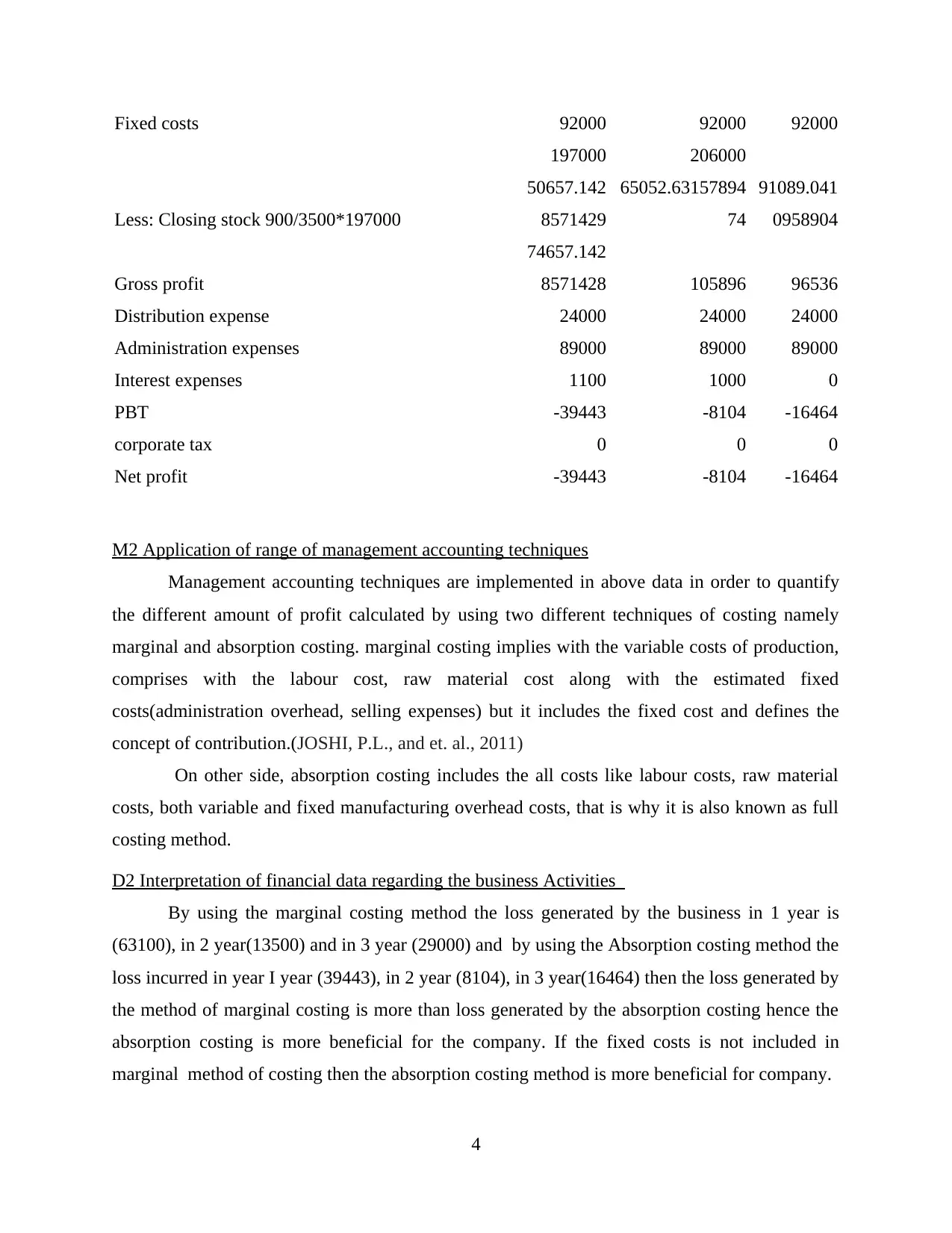
Fixed costs 92000 92000 92000
197000 206000
Less: Closing stock 900/3500*197000
50657.142
8571429
65052.63157894
74
91089.041
0958904
Gross profit
74657.142
8571428 105896 96536
Distribution expense 24000 24000 24000
Administration expenses 89000 89000 89000
Interest expenses 1100 1000 0
PBT -39443 -8104 -16464
corporate tax 0 0 0
Net profit -39443 -8104 -16464
M2 Application of range of management accounting techniques
Management accounting techniques are implemented in above data in order to quantify
the different amount of profit calculated by using two different techniques of costing namely
marginal and absorption costing. marginal costing implies with the variable costs of production,
comprises with the labour cost, raw material cost along with the estimated fixed
costs(administration overhead, selling expenses) but it includes the fixed cost and defines the
concept of contribution.(JOSHI, P.L., and et. al., 2011)
On other side, absorption costing includes the all costs like labour costs, raw material
costs, both variable and fixed manufacturing overhead costs, that is why it is also known as full
costing method.
D2 Interpretation of financial data regarding the business Activities
By using the marginal costing method the loss generated by the business in 1 year is
(63100), in 2 year(13500) and in 3 year (29000) and by using the Absorption costing method the
loss incurred in year I year (39443), in 2 year (8104), in 3 year(16464) then the loss generated by
the method of marginal costing is more than loss generated by the absorption costing hence the
absorption costing is more beneficial for the company. If the fixed costs is not included in
marginal method of costing then the absorption costing method is more beneficial for company.
4
197000 206000
Less: Closing stock 900/3500*197000
50657.142
8571429
65052.63157894
74
91089.041
0958904
Gross profit
74657.142
8571428 105896 96536
Distribution expense 24000 24000 24000
Administration expenses 89000 89000 89000
Interest expenses 1100 1000 0
PBT -39443 -8104 -16464
corporate tax 0 0 0
Net profit -39443 -8104 -16464
M2 Application of range of management accounting techniques
Management accounting techniques are implemented in above data in order to quantify
the different amount of profit calculated by using two different techniques of costing namely
marginal and absorption costing. marginal costing implies with the variable costs of production,
comprises with the labour cost, raw material cost along with the estimated fixed
costs(administration overhead, selling expenses) but it includes the fixed cost and defines the
concept of contribution.(JOSHI, P.L., and et. al., 2011)
On other side, absorption costing includes the all costs like labour costs, raw material
costs, both variable and fixed manufacturing overhead costs, that is why it is also known as full
costing method.
D2 Interpretation of financial data regarding the business Activities
By using the marginal costing method the loss generated by the business in 1 year is
(63100), in 2 year(13500) and in 3 year (29000) and by using the Absorption costing method the
loss incurred in year I year (39443), in 2 year (8104), in 3 year(16464) then the loss generated by
the method of marginal costing is more than loss generated by the absorption costing hence the
absorption costing is more beneficial for the company. If the fixed costs is not included in
marginal method of costing then the absorption costing method is more beneficial for company.
4
Paraphrase This Document
Need a fresh take? Get an instant paraphrase of this document with our AI Paraphraser
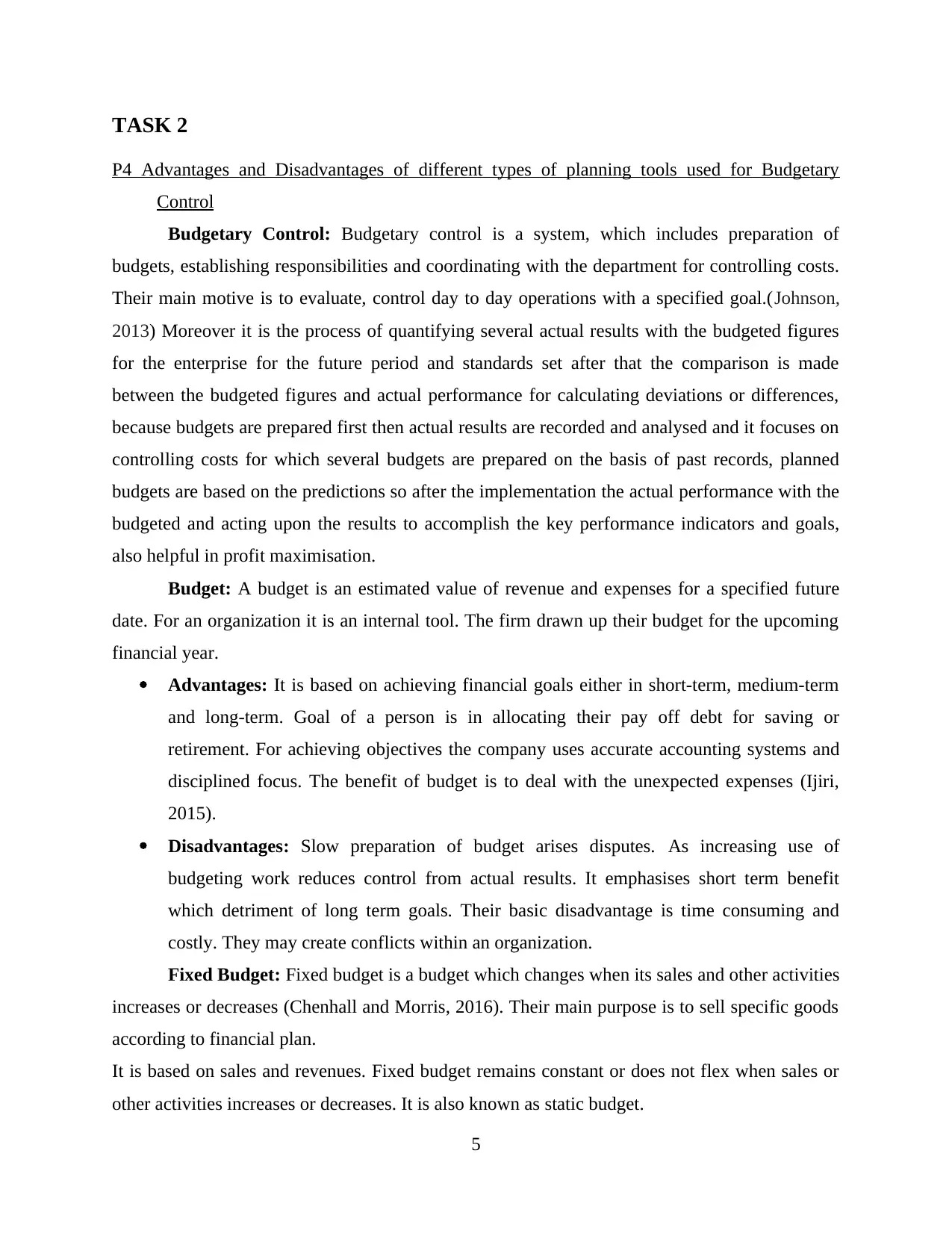
TASK 2
P4 Advantages and Disadvantages of different types of planning tools used for Budgetary
Control
Budgetary Control: Budgetary control is a system, which includes preparation of
budgets, establishing responsibilities and coordinating with the department for controlling costs.
Their main motive is to evaluate, control day to day operations with a specified goal.(Johnson,
2013) Moreover it is the process of quantifying several actual results with the budgeted figures
for the enterprise for the future period and standards set after that the comparison is made
between the budgeted figures and actual performance for calculating deviations or differences,
because budgets are prepared first then actual results are recorded and analysed and it focuses on
controlling costs for which several budgets are prepared on the basis of past records, planned
budgets are based on the predictions so after the implementation the actual performance with the
budgeted and acting upon the results to accomplish the key performance indicators and goals,
also helpful in profit maximisation.
Budget: A budget is an estimated value of revenue and expenses for a specified future
date. For an organization it is an internal tool. The firm drawn up their budget for the upcoming
financial year.
Advantages: It is based on achieving financial goals either in short-term, medium-term
and long-term. Goal of a person is in allocating their pay off debt for saving or
retirement. For achieving objectives the company uses accurate accounting systems and
disciplined focus. The benefit of budget is to deal with the unexpected expenses (Ijiri,
2015).
Disadvantages: Slow preparation of budget arises disputes. As increasing use of
budgeting work reduces control from actual results. It emphasises short term benefit
which detriment of long term goals. Their basic disadvantage is time consuming and
costly. They may create conflicts within an organization.
Fixed Budget: Fixed budget is a budget which changes when its sales and other activities
increases or decreases (Chenhall and Morris, 2016). Their main purpose is to sell specific goods
according to financial plan.
It is based on sales and revenues. Fixed budget remains constant or does not flex when sales or
other activities increases or decreases. It is also known as static budget.
5
P4 Advantages and Disadvantages of different types of planning tools used for Budgetary
Control
Budgetary Control: Budgetary control is a system, which includes preparation of
budgets, establishing responsibilities and coordinating with the department for controlling costs.
Their main motive is to evaluate, control day to day operations with a specified goal.(Johnson,
2013) Moreover it is the process of quantifying several actual results with the budgeted figures
for the enterprise for the future period and standards set after that the comparison is made
between the budgeted figures and actual performance for calculating deviations or differences,
because budgets are prepared first then actual results are recorded and analysed and it focuses on
controlling costs for which several budgets are prepared on the basis of past records, planned
budgets are based on the predictions so after the implementation the actual performance with the
budgeted and acting upon the results to accomplish the key performance indicators and goals,
also helpful in profit maximisation.
Budget: A budget is an estimated value of revenue and expenses for a specified future
date. For an organization it is an internal tool. The firm drawn up their budget for the upcoming
financial year.
Advantages: It is based on achieving financial goals either in short-term, medium-term
and long-term. Goal of a person is in allocating their pay off debt for saving or
retirement. For achieving objectives the company uses accurate accounting systems and
disciplined focus. The benefit of budget is to deal with the unexpected expenses (Ijiri,
2015).
Disadvantages: Slow preparation of budget arises disputes. As increasing use of
budgeting work reduces control from actual results. It emphasises short term benefit
which detriment of long term goals. Their basic disadvantage is time consuming and
costly. They may create conflicts within an organization.
Fixed Budget: Fixed budget is a budget which changes when its sales and other activities
increases or decreases (Chenhall and Morris, 2016). Their main purpose is to sell specific goods
according to financial plan.
It is based on sales and revenues. Fixed budget remains constant or does not flex when sales or
other activities increases or decreases. It is also known as static budget.
5
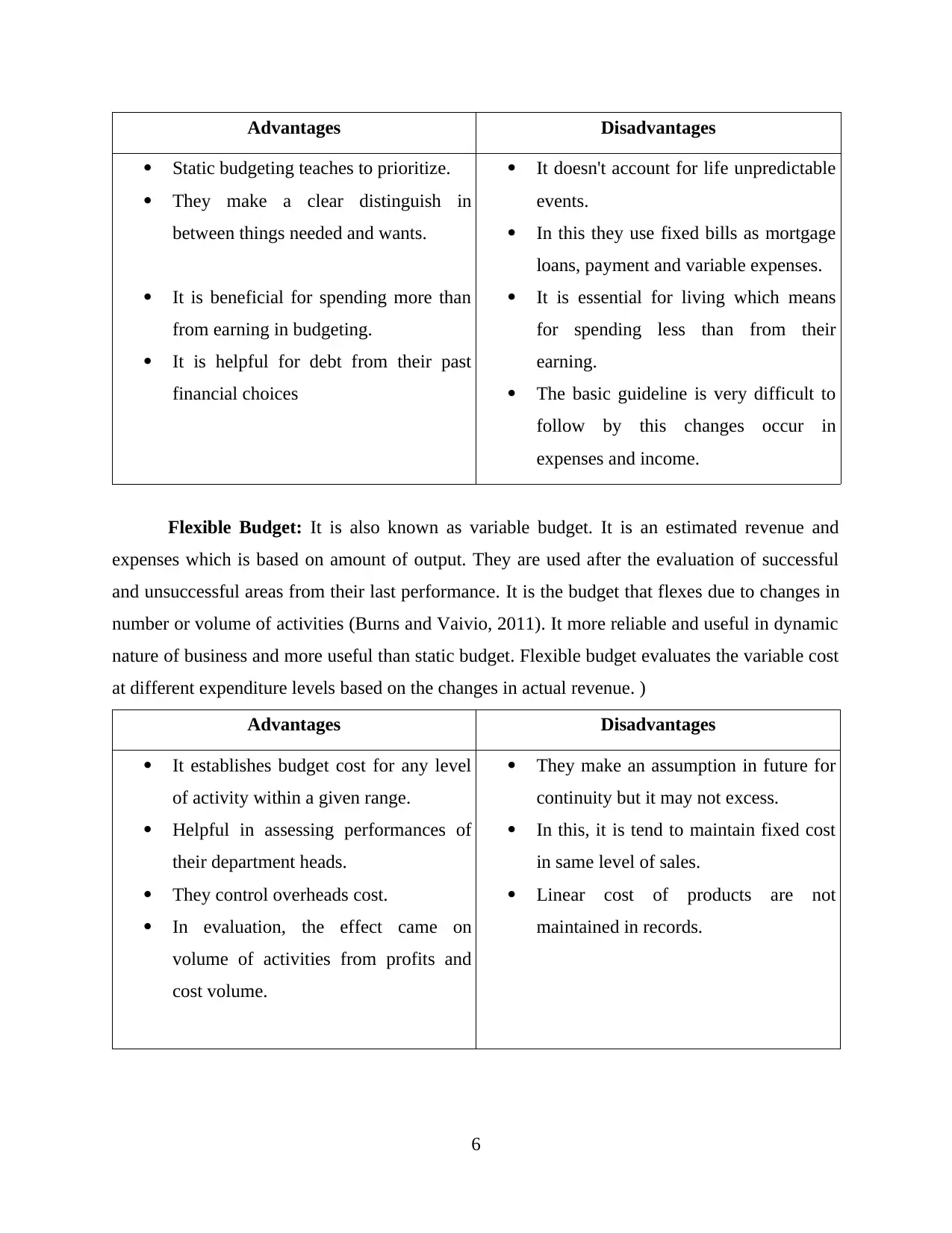
Advantages Disadvantages
Static budgeting teaches to prioritize.
They make a clear distinguish in
between things needed and wants.
It is beneficial for spending more than
from earning in budgeting.
It is helpful for debt from their past
financial choices
It doesn't account for life unpredictable
events.
In this they use fixed bills as mortgage
loans, payment and variable expenses.
It is essential for living which means
for spending less than from their
earning.
The basic guideline is very difficult to
follow by this changes occur in
expenses and income.
Flexible Budget: It is also known as variable budget. It is an estimated revenue and
expenses which is based on amount of output. They are used after the evaluation of successful
and unsuccessful areas from their last performance. It is the budget that flexes due to changes in
number or volume of activities (Burns and Vaivio, 2011). It more reliable and useful in dynamic
nature of business and more useful than static budget. Flexible budget evaluates the variable cost
at different expenditure levels based on the changes in actual revenue. )
Advantages Disadvantages
It establishes budget cost for any level
of activity within a given range.
Helpful in assessing performances of
their department heads.
They control overheads cost.
In evaluation, the effect came on
volume of activities from profits and
cost volume.
They make an assumption in future for
continuity but it may not excess.
In this, it is tend to maintain fixed cost
in same level of sales.
Linear cost of products are not
maintained in records.
6
Static budgeting teaches to prioritize.
They make a clear distinguish in
between things needed and wants.
It is beneficial for spending more than
from earning in budgeting.
It is helpful for debt from their past
financial choices
It doesn't account for life unpredictable
events.
In this they use fixed bills as mortgage
loans, payment and variable expenses.
It is essential for living which means
for spending less than from their
earning.
The basic guideline is very difficult to
follow by this changes occur in
expenses and income.
Flexible Budget: It is also known as variable budget. It is an estimated revenue and
expenses which is based on amount of output. They are used after the evaluation of successful
and unsuccessful areas from their last performance. It is the budget that flexes due to changes in
number or volume of activities (Burns and Vaivio, 2011). It more reliable and useful in dynamic
nature of business and more useful than static budget. Flexible budget evaluates the variable cost
at different expenditure levels based on the changes in actual revenue. )
Advantages Disadvantages
It establishes budget cost for any level
of activity within a given range.
Helpful in assessing performances of
their department heads.
They control overheads cost.
In evaluation, the effect came on
volume of activities from profits and
cost volume.
They make an assumption in future for
continuity but it may not excess.
In this, it is tend to maintain fixed cost
in same level of sales.
Linear cost of products are not
maintained in records.
6
⊘ This is a preview!⊘
Do you want full access?
Subscribe today to unlock all pages.

Trusted by 1+ million students worldwide
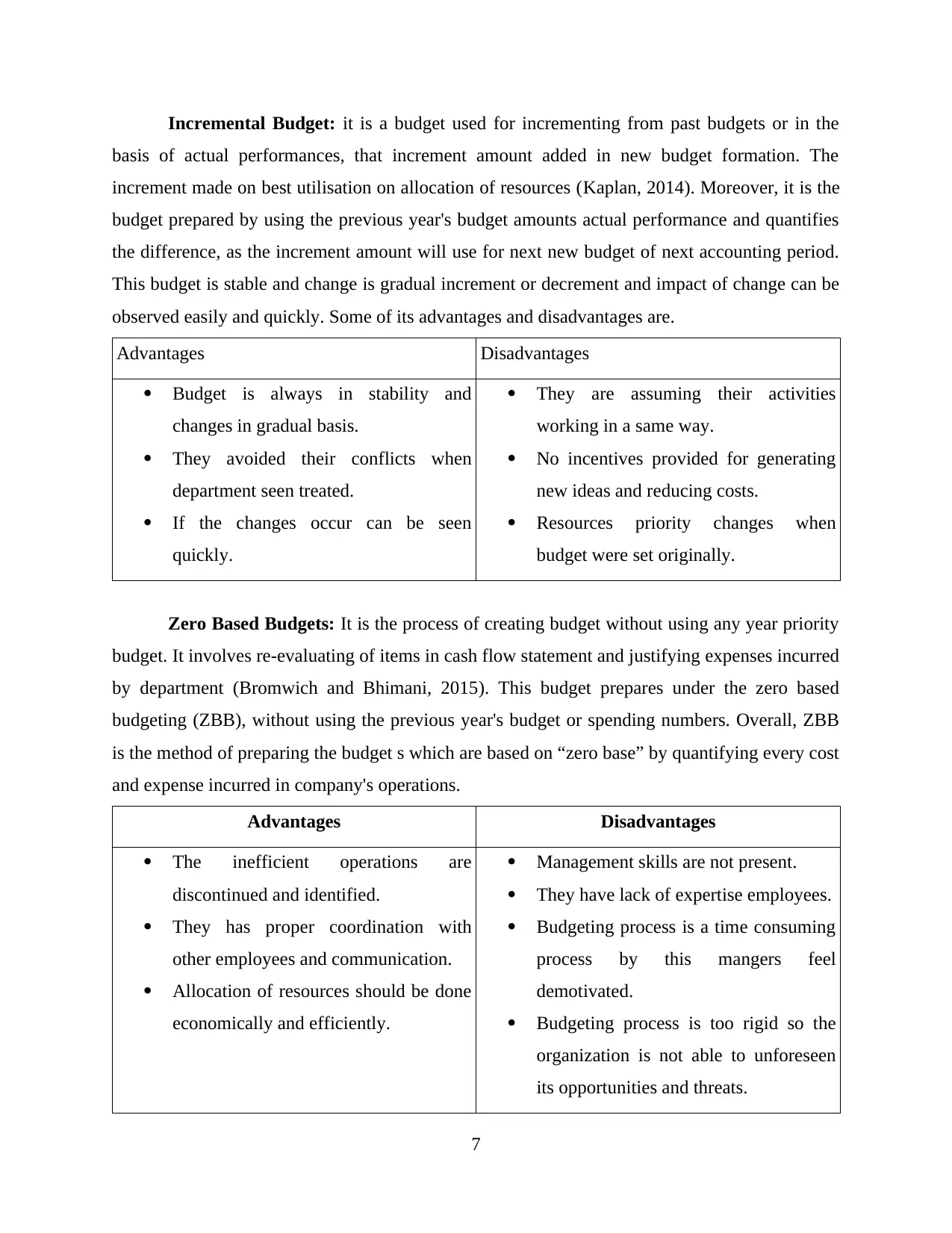
Incremental Budget: it is a budget used for incrementing from past budgets or in the
basis of actual performances, that increment amount added in new budget formation. The
increment made on best utilisation on allocation of resources (Kaplan, 2014). Moreover, it is the
budget prepared by using the previous year's budget amounts actual performance and quantifies
the difference, as the increment amount will use for next new budget of next accounting period.
This budget is stable and change is gradual increment or decrement and impact of change can be
observed easily and quickly. Some of its advantages and disadvantages are.
Advantages Disadvantages
Budget is always in stability and
changes in gradual basis.
They avoided their conflicts when
department seen treated.
If the changes occur can be seen
quickly.
They are assuming their activities
working in a same way.
No incentives provided for generating
new ideas and reducing costs.
Resources priority changes when
budget were set originally.
Zero Based Budgets: It is the process of creating budget without using any year priority
budget. It involves re-evaluating of items in cash flow statement and justifying expenses incurred
by department (Bromwich and Bhimani, 2015). This budget prepares under the zero based
budgeting (ZBB), without using the previous year's budget or spending numbers. Overall, ZBB
is the method of preparing the budget s which are based on “zero base” by quantifying every cost
and expense incurred in company's operations.
Advantages Disadvantages
The inefficient operations are
discontinued and identified.
They has proper coordination with
other employees and communication.
Allocation of resources should be done
economically and efficiently.
Management skills are not present.
They have lack of expertise employees.
Budgeting process is a time consuming
process by this mangers feel
demotivated.
Budgeting process is too rigid so the
organization is not able to unforeseen
its opportunities and threats.
7
basis of actual performances, that increment amount added in new budget formation. The
increment made on best utilisation on allocation of resources (Kaplan, 2014). Moreover, it is the
budget prepared by using the previous year's budget amounts actual performance and quantifies
the difference, as the increment amount will use for next new budget of next accounting period.
This budget is stable and change is gradual increment or decrement and impact of change can be
observed easily and quickly. Some of its advantages and disadvantages are.
Advantages Disadvantages
Budget is always in stability and
changes in gradual basis.
They avoided their conflicts when
department seen treated.
If the changes occur can be seen
quickly.
They are assuming their activities
working in a same way.
No incentives provided for generating
new ideas and reducing costs.
Resources priority changes when
budget were set originally.
Zero Based Budgets: It is the process of creating budget without using any year priority
budget. It involves re-evaluating of items in cash flow statement and justifying expenses incurred
by department (Bromwich and Bhimani, 2015). This budget prepares under the zero based
budgeting (ZBB), without using the previous year's budget or spending numbers. Overall, ZBB
is the method of preparing the budget s which are based on “zero base” by quantifying every cost
and expense incurred in company's operations.
Advantages Disadvantages
The inefficient operations are
discontinued and identified.
They has proper coordination with
other employees and communication.
Allocation of resources should be done
economically and efficiently.
Management skills are not present.
They have lack of expertise employees.
Budgeting process is a time consuming
process by this mangers feel
demotivated.
Budgeting process is too rigid so the
organization is not able to unforeseen
its opportunities and threats.
7
Paraphrase This Document
Need a fresh take? Get an instant paraphrase of this document with our AI Paraphraser
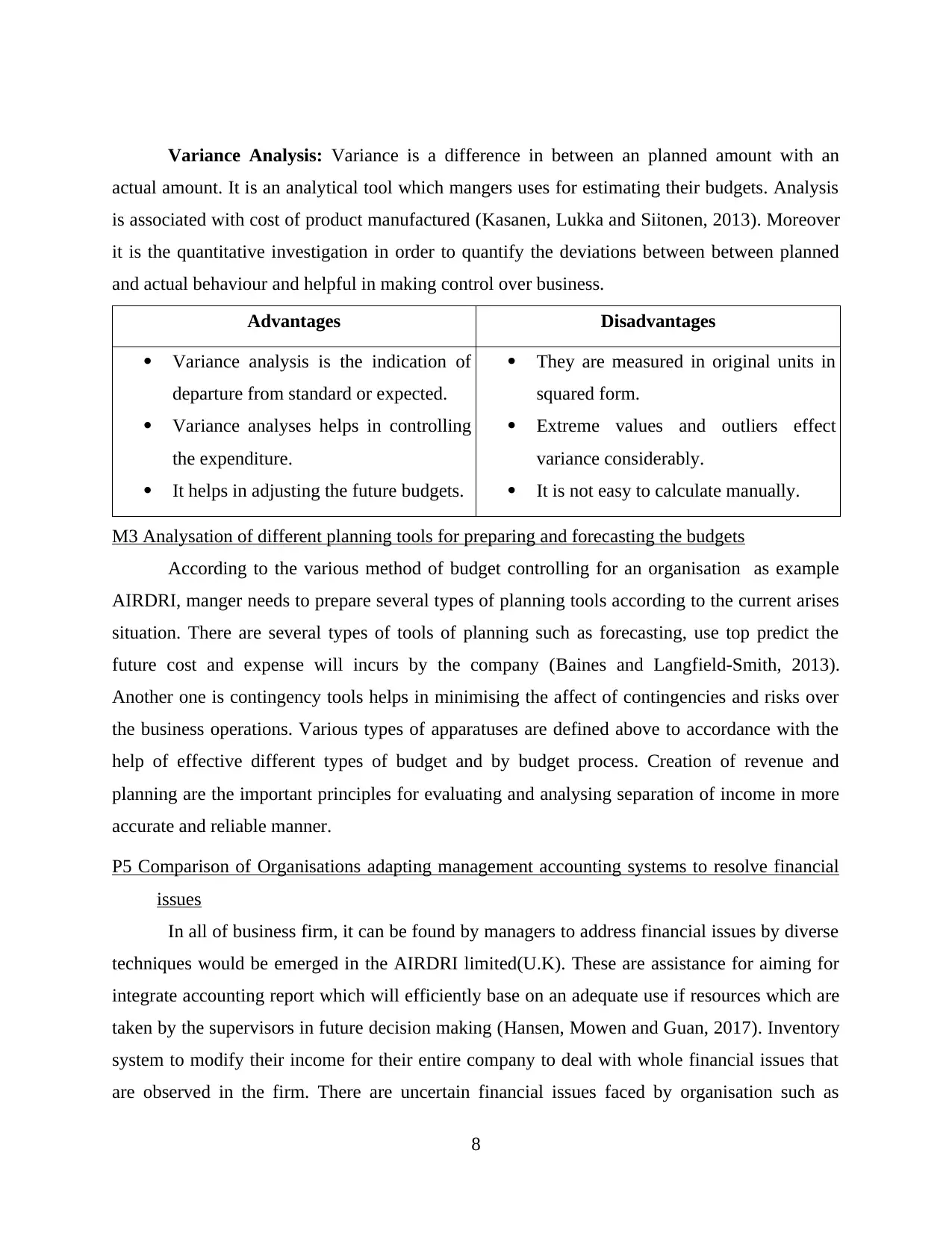
Variance Analysis: Variance is a difference in between an planned amount with an
actual amount. It is an analytical tool which mangers uses for estimating their budgets. Analysis
is associated with cost of product manufactured (Kasanen, Lukka and Siitonen, 2013). Moreover
it is the quantitative investigation in order to quantify the deviations between between planned
and actual behaviour and helpful in making control over business.
Advantages Disadvantages
Variance analysis is the indication of
departure from standard or expected.
Variance analyses helps in controlling
the expenditure.
It helps in adjusting the future budgets.
They are measured in original units in
squared form.
Extreme values and outliers effect
variance considerably.
It is not easy to calculate manually.
M3 Analysation of different planning tools for preparing and forecasting the budgets
According to the various method of budget controlling for an organisation as example
AIRDRI, manger needs to prepare several types of planning tools according to the current arises
situation. There are several types of tools of planning such as forecasting, use top predict the
future cost and expense will incurs by the company (Baines and Langfield-Smith, 2013).
Another one is contingency tools helps in minimising the affect of contingencies and risks over
the business operations. Various types of apparatuses are defined above to accordance with the
help of effective different types of budget and by budget process. Creation of revenue and
planning are the important principles for evaluating and analysing separation of income in more
accurate and reliable manner.
P5 Comparison of Organisations adapting management accounting systems to resolve financial
issues
In all of business firm, it can be found by managers to address financial issues by diverse
techniques would be emerged in the AIRDRI limited(U.K). These are assistance for aiming for
integrate accounting report which will efficiently base on an adequate use if resources which are
taken by the supervisors in future decision making (Hansen, Mowen and Guan, 2017). Inventory
system to modify their income for their entire company to deal with whole financial issues that
are observed in the firm. There are uncertain financial issues faced by organisation such as
8
actual amount. It is an analytical tool which mangers uses for estimating their budgets. Analysis
is associated with cost of product manufactured (Kasanen, Lukka and Siitonen, 2013). Moreover
it is the quantitative investigation in order to quantify the deviations between between planned
and actual behaviour and helpful in making control over business.
Advantages Disadvantages
Variance analysis is the indication of
departure from standard or expected.
Variance analyses helps in controlling
the expenditure.
It helps in adjusting the future budgets.
They are measured in original units in
squared form.
Extreme values and outliers effect
variance considerably.
It is not easy to calculate manually.
M3 Analysation of different planning tools for preparing and forecasting the budgets
According to the various method of budget controlling for an organisation as example
AIRDRI, manger needs to prepare several types of planning tools according to the current arises
situation. There are several types of tools of planning such as forecasting, use top predict the
future cost and expense will incurs by the company (Baines and Langfield-Smith, 2013).
Another one is contingency tools helps in minimising the affect of contingencies and risks over
the business operations. Various types of apparatuses are defined above to accordance with the
help of effective different types of budget and by budget process. Creation of revenue and
planning are the important principles for evaluating and analysing separation of income in more
accurate and reliable manner.
P5 Comparison of Organisations adapting management accounting systems to resolve financial
issues
In all of business firm, it can be found by managers to address financial issues by diverse
techniques would be emerged in the AIRDRI limited(U.K). These are assistance for aiming for
integrate accounting report which will efficiently base on an adequate use if resources which are
taken by the supervisors in future decision making (Hansen, Mowen and Guan, 2017). Inventory
system to modify their income for their entire company to deal with whole financial issues that
are observed in the firm. There are uncertain financial issues faced by organisation such as
8
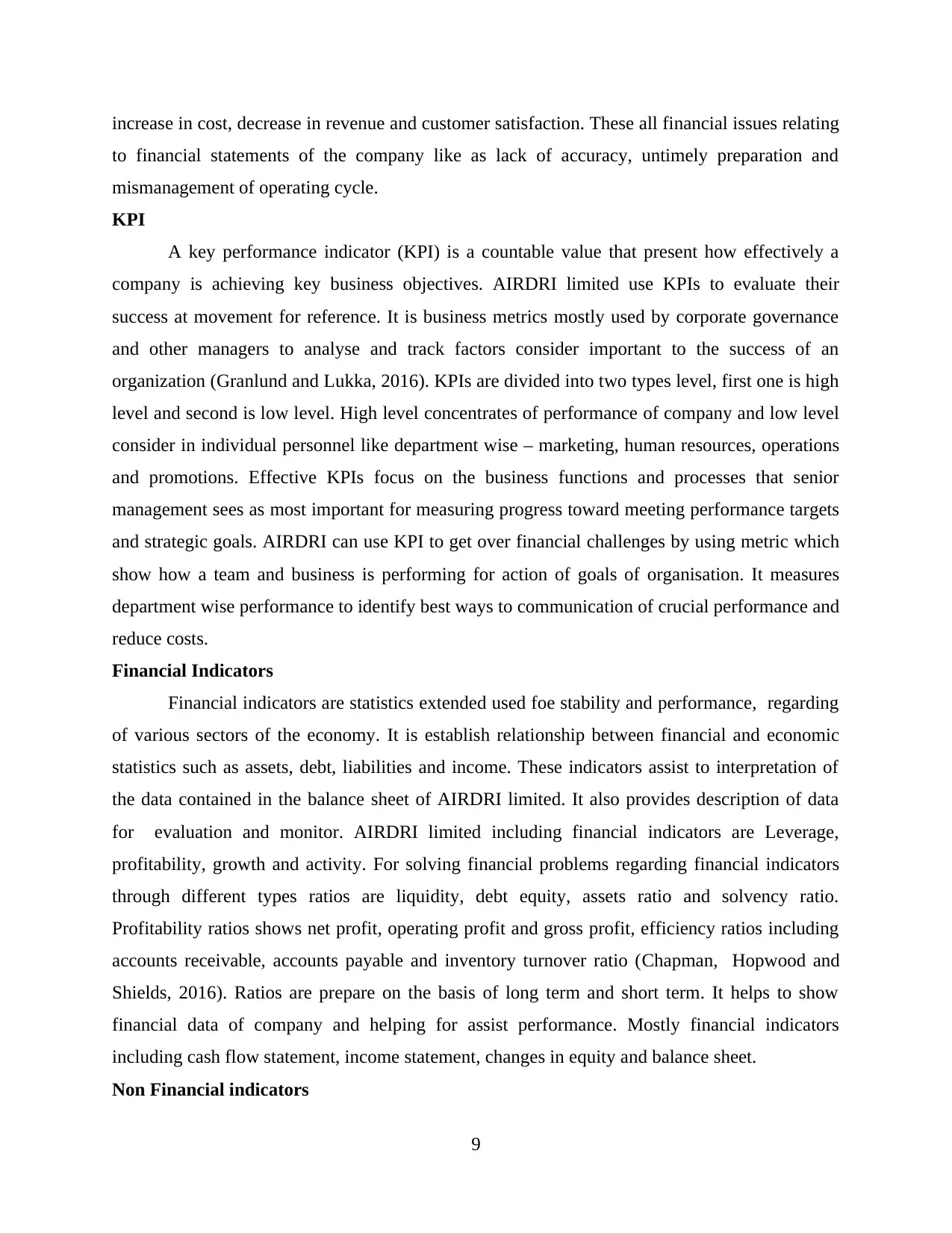
increase in cost, decrease in revenue and customer satisfaction. These all financial issues relating
to financial statements of the company like as lack of accuracy, untimely preparation and
mismanagement of operating cycle.
KPI
A key performance indicator (KPI) is a countable value that present how effectively a
company is achieving key business objectives. AIRDRI limited use KPIs to evaluate their
success at movement for reference. It is business metrics mostly used by corporate governance
and other managers to analyse and track factors consider important to the success of an
organization (Granlund and Lukka, 2016). KPIs are divided into two types level, first one is high
level and second is low level. High level concentrates of performance of company and low level
consider in individual personnel like department wise – marketing, human resources, operations
and promotions. Effective KPIs focus on the business functions and processes that senior
management sees as most important for measuring progress toward meeting performance targets
and strategic goals. AIRDRI can use KPI to get over financial challenges by using metric which
show how a team and business is performing for action of goals of organisation. It measures
department wise performance to identify best ways to communication of crucial performance and
reduce costs.
Financial Indicators
Financial indicators are statistics extended used foe stability and performance, regarding
of various sectors of the economy. It is establish relationship between financial and economic
statistics such as assets, debt, liabilities and income. These indicators assist to interpretation of
the data contained in the balance sheet of AIRDRI limited. It also provides description of data
for evaluation and monitor. AIRDRI limited including financial indicators are Leverage,
profitability, growth and activity. For solving financial problems regarding financial indicators
through different types ratios are liquidity, debt equity, assets ratio and solvency ratio.
Profitability ratios shows net profit, operating profit and gross profit, efficiency ratios including
accounts receivable, accounts payable and inventory turnover ratio (Chapman, Hopwood and
Shields, 2016). Ratios are prepare on the basis of long term and short term. It helps to show
financial data of company and helping for assist performance. Mostly financial indicators
including cash flow statement, income statement, changes in equity and balance sheet.
Non Financial indicators
9
to financial statements of the company like as lack of accuracy, untimely preparation and
mismanagement of operating cycle.
KPI
A key performance indicator (KPI) is a countable value that present how effectively a
company is achieving key business objectives. AIRDRI limited use KPIs to evaluate their
success at movement for reference. It is business metrics mostly used by corporate governance
and other managers to analyse and track factors consider important to the success of an
organization (Granlund and Lukka, 2016). KPIs are divided into two types level, first one is high
level and second is low level. High level concentrates of performance of company and low level
consider in individual personnel like department wise – marketing, human resources, operations
and promotions. Effective KPIs focus on the business functions and processes that senior
management sees as most important for measuring progress toward meeting performance targets
and strategic goals. AIRDRI can use KPI to get over financial challenges by using metric which
show how a team and business is performing for action of goals of organisation. It measures
department wise performance to identify best ways to communication of crucial performance and
reduce costs.
Financial Indicators
Financial indicators are statistics extended used foe stability and performance, regarding
of various sectors of the economy. It is establish relationship between financial and economic
statistics such as assets, debt, liabilities and income. These indicators assist to interpretation of
the data contained in the balance sheet of AIRDRI limited. It also provides description of data
for evaluation and monitor. AIRDRI limited including financial indicators are Leverage,
profitability, growth and activity. For solving financial problems regarding financial indicators
through different types ratios are liquidity, debt equity, assets ratio and solvency ratio.
Profitability ratios shows net profit, operating profit and gross profit, efficiency ratios including
accounts receivable, accounts payable and inventory turnover ratio (Chapman, Hopwood and
Shields, 2016). Ratios are prepare on the basis of long term and short term. It helps to show
financial data of company and helping for assist performance. Mostly financial indicators
including cash flow statement, income statement, changes in equity and balance sheet.
Non Financial indicators
9
⊘ This is a preview!⊘
Do you want full access?
Subscribe today to unlock all pages.

Trusted by 1+ million students worldwide
1 out of 17
Related Documents
Your All-in-One AI-Powered Toolkit for Academic Success.
+13062052269
info@desklib.com
Available 24*7 on WhatsApp / Email
![[object Object]](/_next/static/media/star-bottom.7253800d.svg)
Unlock your academic potential
Copyright © 2020–2025 A2Z Services. All Rights Reserved. Developed and managed by ZUCOL.





